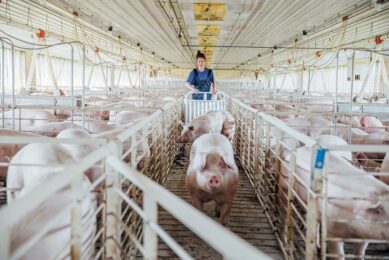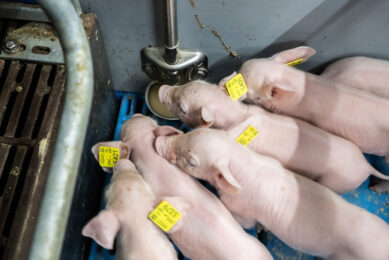Toxoplasma gondii control – an ongoing challenge

I was a bit shocked by a recent study that looked at Toxoplasma gondii prevalence in pigs. In many countries one out of six pigs carry the zoonotic parasite with them. In some Eastern European countries, the disease is even found in 25% of the pigs!
By Emmy Koeleman
Toxoplasmosis is a parasitic disease and was first reported in pigs in 1951 on a farm in Ohio, USA. The etiologic agent is a protozoan parasite, Toxoplasma gondii is microscopic, measuring 1/200th of a millimetre in length. The parasite infects most genera of warm-blooded animals, including humans, but the primary host is the feline (cat) family. Animals are infected by eating infected meat, by ingestion of faeces of a cat that has itself recently been infected, or by transmission from mother to foetus (Figure 1). Although cats are often blamed for spreading toxoplasmosis, contact with raw meat is a more significant source of human infections in many countries, and faecal contamination of hands is a greater risk factor.
Problem around the world
According to a recent study, about 16% of pigs in Spain carry T. gondii. The work is published in the journal Parasitology International. In the study, the researchers showed that the parasite was present in 24.2% of the sows and 9.7% of the fattening pigs. Besides Spain, T. gondii is also common in other countries: Italy (16.3%), Portugal (15.6%) and Germany (16.5 – 18.5%).
Considering that the annual German production is 45 million pigs, this means that each year about 7.5 million infected carcasses enter the food chain. Higher values are seen in Serbia (28.9%) and Poland (26.4%). Lower values are seen in Sweden (5.2%) and the Netherlands (10.9%). In the last years, the Netherlands has made great efforts to fight Toxoplasma gondii in the Dutch pig population.
Maternally derived antibodies
Another study in Veterinary Parasitology looked at the duration of maternally derived antibodies in T. gondii naturally infected piglets. The Spanish research team investigated the dynamics of T. gondii antibodies in naturally infected piglets from one to 25 weeks of age. Seventy-three piglets from 20 seronegative sows and 20 naturally infected T. gondii seropositive sows were analysed at 1, 3, 6, 9, 12, 15, 18, 22 and 25 weeks of age. Twenty-six of the 73 piglets analysed (35.6%; CI 95%: 25.5-45.7) were seropositive at some point during the study. Seroprevalence in piglets at one and three weeks of age was significantly higher in animals born from seropositive sows (P<0.001 and P=0.02, respectively) as an indication of maternally derived antibodies.
The longest persistence (up to six weeks of age) was observed in piglets whose dam had high T. gondii antibody level (MAT >or=1:500), while persistence of maternally derived antibodies in the piglets born from sows with low antibody titres (maximum 1:50) was shorter and lasted only up to three weeks of age, when the piglets were weaned. The risk of horizontal transmission in piglets increased with age and was higher in piglets during the finishing period. This shows that the decline of T. gondii maternally derived antibodies in naturally infected piglets seems to be associated with the titres of their dams.
Higher prevalence in organic pigs
When talking about Toxoplasmosis, the organic pig farming systems are often mentioned as having a higher incidence rate of the parasite. The Animal Sciences Group of Wageningen University in the Netherlands studied the difference between conventional pig farms (n=30), free range pig farms (n=17) and organic pig farms (n=16). They showed that 4.7% of the free range farms, 1.2 % of the organic farms and 0% of the conventional farms were contaminated with T. gondii. The researchers say that free range and organic farms use more cats for rodent control and therefore have an increased risk of transmitting the parasite. More studies point towards higher incidence of T. gondii infected animals in organic system, thereby posing a dilemma between consumer needs for animal friendly production systems on one hand and wish for safer food on the other hand.
T. gondii free food?
To solve this dilemma further knowledge is needed concerning possible strategies to prevent the risk of contracting toxoplasmosis via the consumption of infected meat from high welfare animal production systems (Toxoplasmosis-free food). Or should we also better educate consumers to prepare and cook the meat well, so that risks are minimised? Is it possible, Toxoplasmosis-free food or just an illusion?
Figure 1. T. gondii life cycle.











